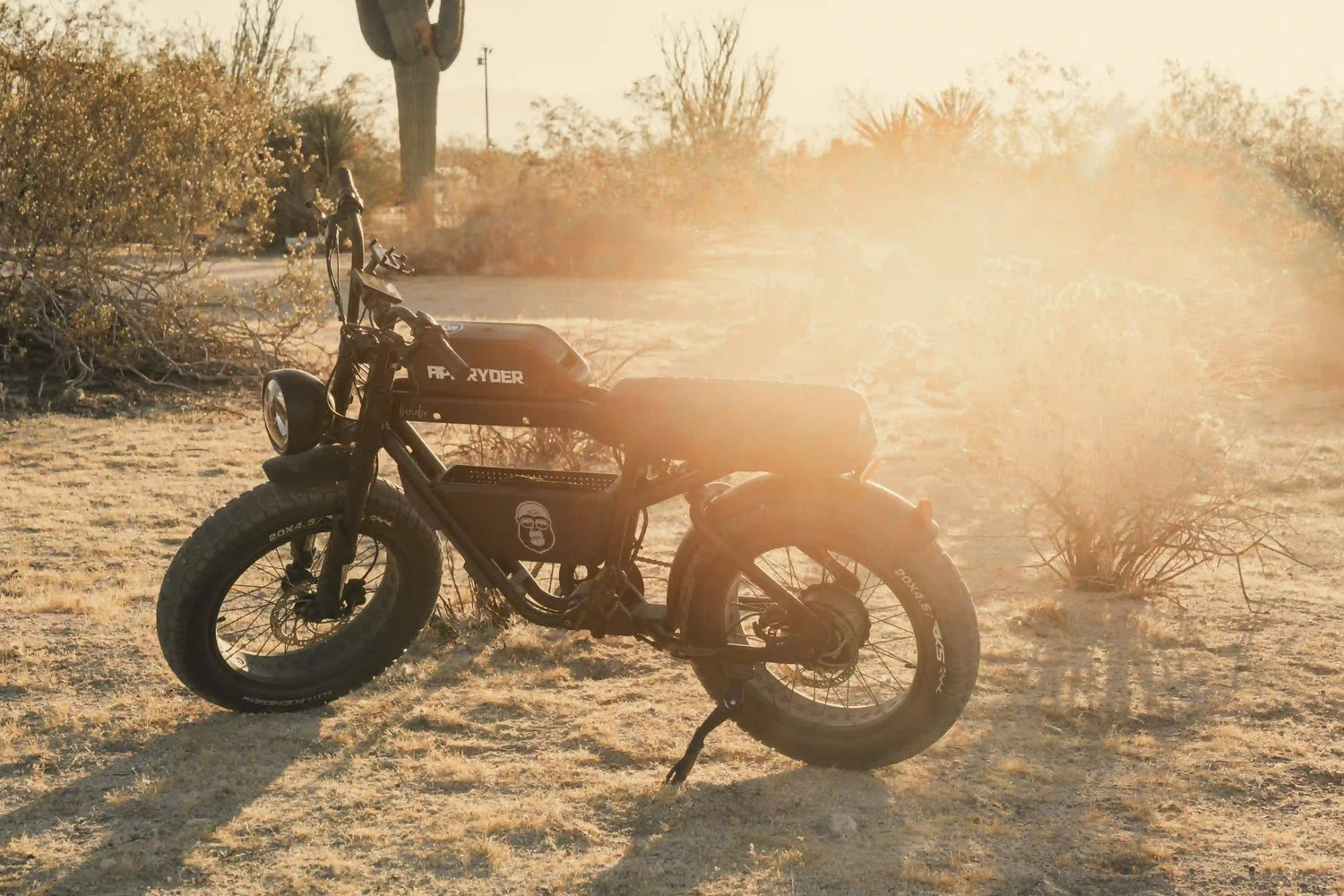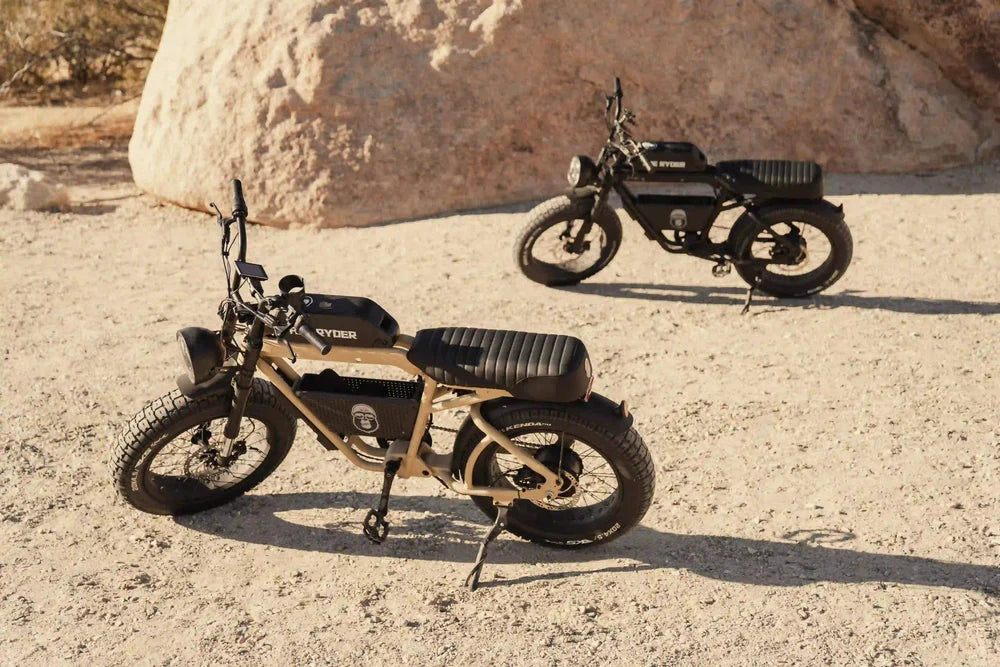Electric-powered vehicles have changed the way people travel and present a whole new range of eco-friendly alternatives. Of these, two of the most popular options are e-bikes and e-motorcycles, which answer different needs. Understanding their differences, advantages, and limitations is the key to finding out which suits your lifestyle better.
After reading our blog post, don't forget to check our fat tire and commuter e-bike collections.
What Sets E-Bikes Apart from E-Motorcycles?
Whereas e-bikes and e-motorcycles both run on electric motors, they are quite different in purpose, design, and function. The e-bike marries traditional cycling to an electric boost. With a motor and a battery, e-bikes assist the pedal, making uphill climbs and long lengths much less exhausting. Light and multi-purpose, top speed generally reaches 20-28 mph. They are excellent for short distance commutes, fitness-oriented, or even the truly environmentally conscious commuter.
E-motorcycles are no different from the regular motorcycles, except with electrical power. For building and construction, they are made for speed, power, and range, reaching 45+ mph-hence fit for long-distance travel and highway commutes. They assure the same high performance one would look forward to with any motorcycle but sans the gasoline element.
Choosing Between E-Bike and E-Motorcycle: Key Factors
Where it excels much is in an easy-go urban commute and recreational rides while doing light adventure off-road adventures. E-bikes blend active commuting and convenience, make for a considerably 'greener' mode of commute, and a less physically strenuous one too. For tough terrain or commuting longer distances needing speed, nothing beats e-motorcycles, packing unmatched power for ultimate endurance.
E-bikes are compact and can fit in small spaces, such as apartments or offices. Many models fold up, adding to their portability for city dwellers. On the other hand, e-motorcycles require dedicated parking, such as a garage or outdoor lot, due to their size and weight. If space is limited, e-bikes offer far more flexibility.
E-bikes are easy to handle and do not require much or any training; hence, they can be used by a broad section of people. They also come with low maintenance costs and few legal liabilities. E-motorcycles demand experience since they are faster, heavier, and more complex to operate. Often, they require licensing and insurance, adding to the responsibilities of owning one.
Cost Comparison
For budget buyers, e-bikes are pretty attractive, ranging in price from $800 to $4,000, depending on the capacity of the battery, the power of the motor, and features such as built-in displays or smart connectivity. Prices like these make e-bikes a pretty great entry-level choice for those looking into electric transportation. On the other hand, e-motorcycles begin at about $3,000, while really nice models can reach over $20,000. This comes with advanced engineering, larger batteries, and the robust build required for high-speed performance. For a rider seeking power and range, this will be a good investment to begin with, though much higher in cost compared to an e-bike.
By far, the biggest advantage of e-bikes is the extremely low cost to operate one. Most e-bikes charge for less than $1 and are pretty economical to use for daily usage and commutes over small distances. They are also easier to maintain since there are fewer complicated components in an e-bike. The batteries are bigger in an e-motorcycle and take a few dollars for a complete charge. That the sophisticating of the braking systems, motors, and electrics demands more frequent service and specialized ones raises maintenance costs over time. These running costs should be one of the aspects to consider regarding the practicality of e-motorcycles.
E-bikes are way cheaper because of fewer associated costs. They are usually not required to be registered, licensed, or insured, thus saving owners a lot of money. This makes them relatively more available for younger riders or those looking for ease-a motorcycle alternative. As for e-motorcycles, they demand necessary registration, insurance, and a motorcycle license, adding to their overall cost. All these long-term financial commitments added to their higher purchase price and operational costs make the overall investment in e-motorcycles greater.
Performance: Range and Battery Life
E-bikes typically cover 20 - 50 miles on a single charge, ideal for daily errands or weekend rides. Pedal-assist modes can extend battery life, and the ability to switch to manual pedaling ensures you’re never stranded. With ranges spanning 70 - 200 miles, e-motorcycles are built for long distances. Their advanced performance and zero-emission operation make them ideal for urban and intercity commutes, though they rely on the availability of charging stations in your area.
E-bikes are often classified as bicycles, exempting them from licensing, insurance, or registration requirements in most regions. Some areas may impose age or speed restrictions, so it’s important to check local regulations. E-motorcycles, however, are categorized as motor vehicles. Owners must secure a motorcycle endorsement, registration, and insurance. These added responsibilities are worth noting if you’re considering transitioning to an e-motorcycle.
E-bikes are great for light, casual off-road use, while the generally lightweight design of most e-bikes, combined with fat tires and pedal-assist functions, offers the right mix of exercise and ease over rough terrain. E-motorcycles are designed to take on extreme trails and offer amazing power and endurance. Their highly impressive performance qualifies them to manage mountainous, rocky, or highly muddy routes without any hassle. If one seeks ultimate off-roading, it would be on an e-motorcycle.
Which One Fits Your Lifestyle?
It all comes down to your personal needs and priorities. If your needs are for an economical, eco-friendly, and versatile means of transportation for short-distance commutes or recreational rides, there the e-bike stands out. But if speed, range, and power for long-distance or highway travel are what you need, an e-motorcycle gives you that high-performance edge. Both e-bikes and e-motorcycles represent the future of sustainable transportation-innovative solutions to cater to diverse lifestyles.









Leave a comment
All comments are moderated before being published.
This site is protected by hCaptcha and the hCaptcha Privacy Policy and Terms of Service apply.